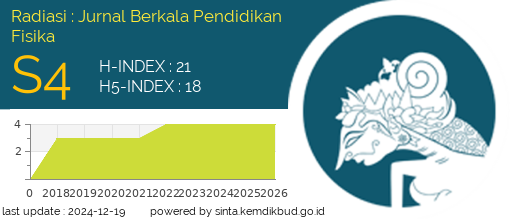Designing Interactive Electronic Module with Collaborative Team Work in Physics Learning
Abstract
This study aims to determine the validity, practicality and effectiveness of interactive electronic modules (e-modules) with collaborative teamwork for physics learning. Design e-modules using the Flip PDF Professional application.This development uses the ADDIE development design (Analysis, Design, Development, Implementation and Evaluation). This research was conducted at senior high school in Purworejo. The test subjects were limited to class X2 with 5 students and a wide trial with 71 students in class X1 class X2. The research instruments used were validation sheets, collaboration skills questionnaires, learning module implementation sheets, collaboration skills observation sheets and student response questionnaires. Study data analysis techniques through validity test, and N-gain. The results of the study obtained: 1) material validation by expert validators obtained an average score of 3.72 in the "very good" category media experts obtained an average score of 3.63 in the "very good" category, so that it was declared very good. 2) the practicality of the media seen from the responses of the students obtained an average percentage of 93.7% in the "very practical" category. 3) the effectiveness of the e-module is seen from the increase in the results of the pre and post collaboration skills questionnaire, namely obtaining an N-gain of 0.68 in the "medium" category. For this reason, the development of interactive e-module with Collaborative Teamwork Learning for physics learning meets valid, practical and effective criteria, to improve students' collaboration skills in Class X senior high school.
Downloads
References
[2] A. D. Puspitasari, “Penerapan media pembelajaran fisika menggunakan modul cetak dan modul elektronik pada siswa SMA,” JPF (Jurnal Pendidikan Fisika) Universitas Islam Negeri Alauddin Makassar, vol. 7, no. 1, pp. 17–25, 2019.
[3] C. E. Erlinawati, S. Bektiarso, and M. Maryani, “Model pembelajaran project based learning berbasis STEM pada pembelajaran fisika,” Fkip E-Proceeding, vol. 4, no. 1, pp. 1–4, 2019.
[4] F. E. Priandono, S. Astutik, and S. Wahyuni, “Pengembangan media audio-visual berbasis kontekstual dalam pembelajaran fisika di SMA,” Jurnal Pembelajaran Fisika, vol. 1, no. 3, pp. 247–253, 2021.
[5] H. F. Sunbanu, M. Mawardi, and K. W. Wardani, “Peningkatan Keterampilan Kolaborasi Siswa Menggunakan Model Pembelajaran Kooperatif Two Stay Two Stray Di Sekolah Dasar,” Jurnal Basicedu, vol. 3, no. 4, pp. 2037–2041, 2019.
[6] Q. A’yun, “Analisis tingkat literasi digital dan keterampilan kolaborasi siswa dalam pembelajaran IPA Kelas VII Secara Daring,” Jurnal Didaktika Pendidikan Dasar, vol. 5, no. 1, pp. 271–290, 2021.
[7] A. Safitri, E. Suyanto, and I. Wahyudi, “Pengembangan Lembar Kerja Peserta Didik Berbasis Collaborative Teamwork Learning Pada Materi Fluida Dinamis Sma Kelas Xi,” Jurnal Pendidikan Fisika, vol. 7, no. 1, pp. 81–92, 2019.
[8] A. Tazkiyah, S. Sulur, and S. Fawaiz, “Pengembangan modul elektronik dengan feedback berbasis android materi suhu dan kalor untuk siswa SMA/MA,” Jurnal Pendidikan Fisika Dan Teknologi, vol. 6, no. 1, pp. 31–38, 2020.
[9] J. P. Tegeh, Model Penelitian Pengembangan. Jakarta: 2014, 2014.
[10] Purwanto, Prinsip-Prinsip dan Teknik Evaluasi Pengajaran. Bandung: 2012, 2012.
[11] D. E. Rahmawati and G. Trimulyono, “Validitas instrumen penilaian Higher Order Thinking Skills (HOTS) pada materi keanekaragaman hayati,” Berkala Ilmiah Pendidikan Biologi (BioEdu), vol. 11, no. 1, pp. 138–147, 2022.
[12] Trianto, Mendesain Model Pembelajaran Inovatif-progresif. Jakarta: 2009, 2009.
[13] Y. Rizqiyani, N. Anriani, and A. S. Pamungkas, “Pengembangan e-modul berbantu kodular pada smarthphone untuk meningkatkan kemampuan literasi matematis siswa SMP,” Jurnal Cendekia: Jurnal Pendidikan Matematika, vol. 6, no. 1, pp. 954–969, 2022.
[14] A. H. Ngurahrai, S. D. Fatmaryanti, and N. Nurhidayati, “Pengembangan Media Pembelajaran Fisika Berbasis Mobile Learning Untuk Meningkatkan Kemampuan Berpikir Kritis Peserta Didik,” Radiasi: Jurnal Berkala Pendidikan Fisika, vol. 12, no. 2, pp. 76–83, 2019.
[15] R. Fahmi, H. Tusa’diah, P. Aswirna, and A. Sabri, “Pengembangan Keterampilan Kolaborasi Melalui Penerapan Modul Interaktif Berbasis TTI,” Natural Science: Jurnal Penelitian Bidang IPA dan Pendidikan IPA, vol. 6, no. 2, pp. 2477–6181, 2020.
[16] M. R. N. Cholis and D. Yulianti, “Pembelajaran Fisika Berbasis Science Technology Engineering And Mathematics (STEM) Untuk Mengembangkan Keterampilan Kolaborasi,” Unnes Physics Education Journal, vol. 9, no. 3, pp. 249–255, 2020.
[17] D. Darmaji, D. A. Kurniawan, A. Astalini, W. Kurniawan, K. Anwar, and A. Lumbantoruan, “Students’ perceptions of electronic’s module in physics practicum,” Journal of Education and Learning (EduLearn), vol. 13, no. 2, pp. 288–294, 2019, doi: 10.11591/edulearn.v13i2.13005.
Copyright (c) 2023 Gigih Anggita, Siska Desy Fatmaryanti, Ashari Ashari, Eko Setyadi Kurniawan

This work is licensed under a Creative Commons Attribution-NonCommercial 4.0 International License.




